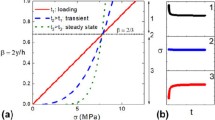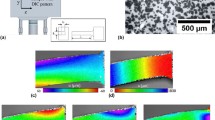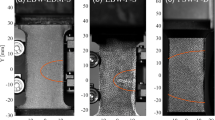Abstract
Bending is emerging as an alternative to uniaxial testing for high-throughput determination of primary-cum-secondary creep parameters. This is feasible because of augmentation of cantilever bending tests with digital image correlation (DIC). Here, we provide guidelines for selecting the patterning medium, spray conditions, and other important parameters for laying high-resolution, high contrast ratio DIC speckle-patterns that are optimal for long-term creep tests performed up to 800°C. Furthermore, an experimental setup for efficiently performing creep experiments in bending at high temperatures is designed and developed. Proper choices of paint, spraying technique, high-resolution image capturing device, and the appropriate heat management system in the mechanical testing unit yield unambiguous correlation in the “DIC augmented bending creep” tests. The developed methodology and the equipment are validated by evaluating the creep behavior of a stainless steel at 750°C by obtaining multiple stress–strain rate pairs from a single test. An excellent match between uniaxial and bending data is observed, thereby paving the way for using DIC augmented bending creep for studying the creep response of materials at high temperatures in a high-throughput fashion.












Similar content being viewed by others
Notes
One may use two cameras, mounted at an angle, and choose an appropriate software package to perform “stereo”-DIC to obtain the 2-D strain field more accurately.1 The description provided here is focused on standard 2-D DIC; however, it is general enough to be easily adapted for stereo-DIC.
The thickness of the coating is determined by number of spray passes.
References
M.A. Sutton, J. Orteu, and H.W. Schreier, Image Correlation for Shape, Motion and Deformation Measurements (New York: Springer, 2009).
P.F. Luo and F.C. Huang, Opt. Lasers Eng. 33, 349 (2000).
R.J. Adrian, Annu. Rev. Fluid Mech. 23, 261 (1991).
V.T. Bickel, A. Manconi, and F. Amann, Remote Sens. 10, 865 (2018).
J.N. Florando, M.M. LeBlanc, and D.H. Lassila, Scr. Mater. 57, 537 (2007).
J.N. Florando, M. Rhee, A. Arsenlis, M.M. Leblanc, and D.H. Lassila, Philos. Mag. Lett. 86, 795 (2006).
N. Sabaté, D. Vogel, A. Gollhardt, J. Marcos, I. Gràcia, C. Cané, and B. Michel, Nanotechnology 17, 5264 (2006).
Y.Z. Dai, C.J. Tay, and F.P. Chiang, Exp. Mech. 31, 348 (1991).
S. Choi and S.P. Shah, Exp. Mech. 37, 307 (1997).
D. Coburn and J. Slevin, Appl. Opt. 34, 5977 (1995).
H. Lu, X. Zhang, and W.G. Knauss, Polym. Eng. Sci. 37, 1053 (1997).
H.J. Sung, S.H. Park, and M.S. Kim, Exp. Fluids 40, 664 (2006).
J.A. Leendertz and J.N. Butters, J. Phys. E. 6, 1107 (1973).
B. Turoń, D. Ziaja, L. Buda-Ożóg, and B. Miller, Arch. Civ. Eng. 64, 31 (2018).
J. Liu, J. Lyons, M. Sutton, and A. Reynolds, J. Eng. Mater. Technol. Trans. ASME 120, 71 (1998).
S.I.A. Jalali, P. Kumar, and V. Jayaram, J. Mater. Res. 35, 353 (2020).
S.I.A. Jalali, P. Kumar, and V. Jayaram, J. Mater. Res. 35, 362 (2020).
ASTM E139-11(2018), Standard Test Methods for Conducting Creep, Creep-Rupture, and Stress-Rupture Tests of Metallic Materials (2018).
S.I.A. Jalali, Evaluation of Power-Law Creep in Bending, IISc Bangalore (2020).
S.I.A. Jalali, P. Kumar, and V. Jayaram, Scr. Mater. 186, 99 (2020).
G. Lionello and L. Cristofolini, Meas. Sci. Technol. 25, 107001 (2014).
M.E. Kassner, Fundamentals of Creep in Metals and Alloys (Massachusetts: Butterworth-Heinemann, Elsevier, 2015).
J. Weertman and J. Blacic, Geophys. Res. Lett. 11, 117 (1984).
S.I.A. Jalali, P. Kumar, and V. Jayaram, JOM 71, 3563 (2019).
K.C. Sahoo, S. Goyal, V. Ganesan, J. Vanaja, G.V. Reddy, P. Padmanabhan, and K. Laha, Mater. High Temp. 36, 388 (2019).
Acknowledgements
The authors would like to thank the Aeronautical Research and Development Board, India (ARDB 0242), and Ministries of Human Resource Development and Power, Government of India (IMPRN 0009) for financially supporting this work. PK also acknowledges the financial support from Tata Trust under its Short-Term Academic Visit Program at the Indian Institute of Science, Bangalore.
Author information
Authors and Affiliations
Corresponding author
Ethics declarations
Conflict of interest
On behalf of all authors, the corresponding author states that there is no conflict of interest.
Additional information
Publisher's Note
Springer Nature remains neutral with regard to jurisdictional claims in published maps and institutional affiliations.
Rights and permissions
About this article
Cite this article
Jalali, S.I.A., Kumar, P. & Jayaram, V. Customized High-Temperature Bending with DIC for High-Throughput Determination of Creep Parameters: Technique, Instrumentation, and Optimization. JOM 72, 4522–4538 (2020). https://doi.org/10.1007/s11837-020-04445-5
Received:
Accepted:
Published:
Issue Date:
DOI: https://doi.org/10.1007/s11837-020-04445-5




